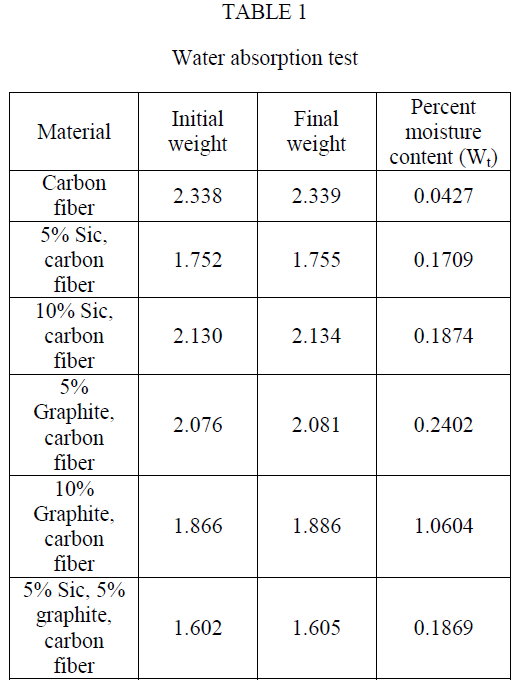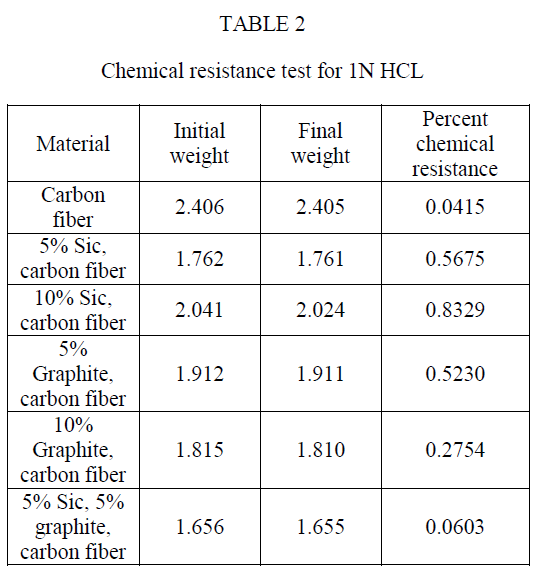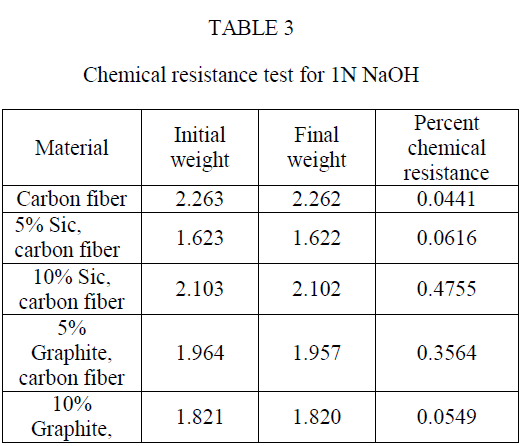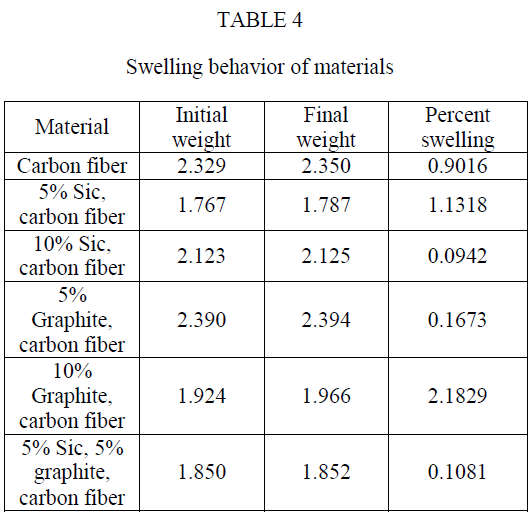ISSN ONLINE(2319-8753)PRINT(2347-6710)
ISSN ONLINE(2319-8753)PRINT(2347-6710)
| Vignesh .C, Kumaresan .K Department of Mechanical Engineering, Park College of Engineering and Technology, Coimbatore, Tamil Nadu, India |
| Related article at Pubmed, Scholar Google |
Visit for more related articles at International Journal of Innovative Research in Science, Engineering and Technology
The effect of water absorption and chemical resistance behavior of materials against acids and alkali solutions was investigated for a carbon fiber polymer matrix composite material. The specimens were immersed in acids and alkalis for several hours and chemical resistance was calculated. The sample specimen carbon fiber materials were filled with filler materials in different ratios. The filler materials are Sic and graphite materials. The behavior against weathering conditions was studied by swelling behavior in toluene solvent with 10% sodium chloride solution at room temperature.
Keywords |
| carbon fiber, effect of filler on ageing resistance, swelling behavior. |
INTRODUCTION |
| The composite materials have wide variety of applications in many fields. One of the most commonly using composite materials are polymer matrix composites. These polymer matrix composites (PMC) are available in different forms. They provided better strength to weight ratio, good corrosion resistance, durability, outstanding insulating properties. This type of polymer composites were easy processing and require material property can be achieved with suitable materials. Carbon fiber is one of a polymer matrix composite which provide excellent mechanical properties. Nowadays carbon fiber is widely using in many fields for their mechanical properties. The carbon fiber along with epoxy resin and filler provide better strength than carbon epoxy material. In this work several types of ageing test were carried out. The ageing is the process that determines the material quality in all dimensions. The accelerated ageing test was conducted on materials to determine the quality of materials in their entire lifespan. The ageing test was conducted on material like water absorption test, chemical resistance, swelling behavior test. |
II. EXPERIMENTAL METHOD |
A.Materials and Processing |
| The carbon fiber material is reinforced with epoxy resin matrix material and curing hardener. The six specimens were manufactured for ageing of material studies. The manufactured six specimens are carbon fibre – epoxy resin, 5% Sic carbon fiber – epoxy resin, 10% Sic carbon fiber – epoxy resin, 5% graphite carbon fiber – epoxy resin, 10% graphite carbon fiber – epoxy resin, 5% Sic 5% graphite carbon fiber – epoxy resin. The materials were manufactured by hand layup method and then by compression moulded method. |
B.Measurement of Water Absorption Test |
| The water absorption test denotes the amount of water that absorbed by the material when heated to certain temperatures. Specimens were made in a size of 20 mm x 20 mm x 3 mm and immersed into distilled water at a temperature of 95oC. Before soaking the materials into distilled water, the specimens were to be weighed on an balance. The accuracy of weigh balance is about ±0.001 g. the weight gain of material is by moisture absorption using the following formula, |
 |
| Where, Wi is the initial weight of specimen, Wf is the weight of the specimen after immersion and Wt is the percent moisture content of specimen. |
| C.Chemical Resistance Test |
| The specimen dimensions of 20 mm x 20 mm x 3 mm were immersed in 100 ml of 1N NaOH and 1N HCL for 48 hours. After this the samples were filtered out, dried and weighed. The percent chemical resistance (Pcr) was calculated in terms of weight loss in following manner: |
 |
| Where Wi is the initial weight of specimen and Wa is the final weight of specimen from acid and alkali solution and Pcr is the percent chemical resistance. |
| D.SwellingBehavior of Material |
| The behavior against weathering conditions was studied by swelling behavior. The swelling behavior of material is studied by soaking the material into a 100 ml of toluene solvent with 10% sodium chloride solution at room temperature for 7 days. The samples were filtered out and excess solvents were removed and weighed by using following equation, |
 |
| Where Wf is the final weight of specimen and Wi is the initial weight of specimen. |
III. RESULT AND DISCUSSION |
| A.Water Absorption Test |
| The specimen is immersed in distilled water for 120 hours at temperature of 90oC. The materials weight was differ from weigh before immersing and after immersing in distilled water. The water absorption test was carried out for following specimens are, |
 |
B.Chemical Resistance Test |
| The materials were immersed in acid and alkali solution for several hours and weighed. The materials are immersed in 100 ml of 1N HCL and 1N NaOH solutions for 48 hours. The materials are weighing before and after immersing in solutions. The samples were filtered out, dried and weighed. The percent chemical resistance (Pcr) was calculated in terms of weight loss. The following table shows the chemical resistance of materials in acid solution. |
 |
| The following table shows the chemical resistance of materials in alkali solutions. |
 |
 |
| C.Swelling Behavior Test |
| To calculate the swelling behavior of materials, the material is soaked in toluene solvent with 10% sodium chloride. The material is allowed at room temperature for 7 days. The weight of material before and after soaking in solvent solution gives the material behavior against weathering conditions. The swelling behavior of materials is given in an following table, |
 |
IV. CONCLUSION |
| The materials are tested in various conditions for different resistance test. In water absorption test the material absorbs distilled water at 95oC most of materials absorbs below 1 percent whereas 10% graphite filled carbon fiber absorbs water more than 1 percent. In chemical resistance test when materials are immersed in HCL and NaOH solutions, the materials chemical resistance is found very high than the 10@ Sic filled material. Its chemical resistivity is nearly 0.8 percent than the other materials. The swelling behavior test shows the materials in weathering conditions. From swelling behavior test, the other materials resistivity against weathering conditions is excellent than the 10% graphite and 5% Sic filled carbon fiber material. |
References |
|